Introduction
In higher education in many countries, the thesis examination is the process of project-based assessment in which students are evaluated to assess the results of their learning process. A thesis examination is a multilayered story of assessment that portrays students’ comprehension and emotions. Dally et al. (2020) reports that the thesis examination is the final step to decide which students have fulfilled the requirements of their language program. In this sense, a thesis examination is not merely the official standardized test, but also the engagement process including the supervisor, supervisors’ feedback, students’ beliefs and emotions. Guloy et al. (2020) found that thesis examinations in higher education can be a means to build students’ identity.
For this reason, the undergraduate thesis examination provides material for a potential discussion of students’ emotions, identities, and experiences. Several studies have mentioned that thesis examination was a positive learning experience for students. For example, “Students perceive the examination session as promoting learning, giving insight into scientific work and a forum with possibilities for the improvement of their thesis” (Bjersa et al., 2018, p.7). However, it remains debatable among scholars how to identify and examine students’ beliefs, values, and perceptions related to thesis examinations.
In past decades, the notion of students’ thesis examination has been well documented in qualitative research (Guloy et al., 2020; Bjerså et al., 2019). In higher education, many studies have addressed how master's and Ph.D. students engage in their professional examination (Bourke & Holbrook, 2013; Dally et al., 2020). However, there is little in the literature on exploring undergraduate students’ experiences. Holbrook et al. (2020) found that their qualitative research study supported previous studies showing that language competence enables students to finish their thesis examination. A growing body of research reports master’s and doctoral experiences while they were taking part in their examinations, but few of the studies investigated student-teachers’ thesis examination in the EFL context.
Wang and Burries (1997) stated that “photovoice is a process by which people can identify, represent and enhance their community through a specific photographic technique” (p. 369). In photovoice, the participants took the picture and narrated their life experiences using their voice (Foster-Fishman, 2005). As part of production of knowledge, “photovoice has three primary objectives: (1) For participants to identify, record, and reflect on community needs; (2) To promote critical dialogue; (3) To reach policy makers to enact social change toward community improvement” (Wang and Burris, 1997, p. 379). In the educational landscape, photovoice has been adopted as a research methodology to explore the students’ life experiences in teaching-learning.
A thesis examination is one of the crucial steps for students that the photovoice technique can explore. Several recent articles (Bjerså et al., 2019; Koltz et al., 2010) have explored this method in thesis examinations. While the review of photovoice in student examination by Bjerså et al., (2019) focuses on undergraduate physiotherapist students' experiences of their bachelor's theses’ examination sessions, the reports of Koltz et al (2010) stress doctoral students and their experiences related to counselor education literature. A major concern of those two articles is to portray students’ life experiences facing the thesis examination using photovoice. Bjerså et al., (2019) emphasize that it is a positive learning experience, giving insight as well as possibilities for improving their thesis. On the other hand, drawing on the findings, the study indicated that thesis examination could be destructive for the relationship when fellow students acted unfairly during the review of their analysis. Meanwhile, Koltz et al. (2010) report on a visual depiction of students' experiences and insight. By using phenomenology covering the concepts of meaning and personal experiences with photovoice and journaling for about six months and semi-structured interviews and U-heuristic of individual reflection, they highlight four themes (self-doubt, tension, industry, and motivation) captured from the doctoral students’ experiences.
To contribute to the growing research interest in student experience during thesis examinations, we focus specifically on EFL student-teachers’ online thesis examination experiences by adopting photovoice and analyzing that data through phenomenology to understand how they react to the situations of online thesis examinations such as emotion, beliefs, perceptions, and experiences during the COVID-19 pandemic. This study is unique in two ways: 1) While photovoice has been used as qualitative data collection method for investigating students experiences of thesis examinations, it has not been used with undergraduates who are becoming teachers. (2) Phenomenology as a qualitative analytical tool has not before been used with photovoice in this context. Our research provides some empirical and contextual contributions and policy in particular to help student-teachers prepare a strategic plan to pass the thesis exam successfully. Additionally, this research will provide better mentoring in thesis supervising situated in EFL teacher education.
Literature Review
Photovoice as a tool for documenting lived student experience
The photovoice technique can be defined as a process of people identifying, representing, and enhancing their social rules and social practices using photographs (Wang & Burries, 1997). From this point of view, we contend that photovoice can be used as a means to explore participants' voice narration and experiences and contribute to the promotion of critical dialogue. In qualitative research, photovoice has been used in a wide range of fields such as marginalized communities, youth members, sexual agency, health issues, and education (e.g., Lynch & Bengtsson, 2018; Malka, 2020; Villacañas de Castro, 2016). Photovoice as critical methodology enables educators and researchers to document students’ lived experiences since this tool can encourage examination of critical incidents in students’ experiences. From a social theory perspective, photovoice serves as the mediation of knowledge production in which students express the reality of life and the capture of social phenomena. In an educational landscape, Malka (2020) reported that photovoice afforded to students critical dialogue, internalization of beliefs, value, and portrayed the phenomenological examination of classroom as social realities.
Thus, photovoice can be defined as creative tool and methodology to capture students’ learning process in the terms of social diversity, classroom innovation, and examination issues. In the photovoice method, people can collect the photos as artefacts of their life experiences. However, people need to narrate their photos into language. Therefore, there are three primary processes to do so; taking the picture, writing a story based on the picture, and uploading it into their files as notes.
Photovoice works with two kinds of pictures, original and metaphor. If the participants took the pictures of themselves (shot by others), they are original pictures. On the other hand, if the pictures represented their emotions or feelings, they are called metaphor pictures.
Anchored to critical research perspective, photovoice can be considered critical pedagogy in which educators and teachers can facilitate students’ learning experiences and explore students’ engagement. Empirical evidence was reported by Lynch & Bengtsson (2018) that the role of photovoice helped students to build their dialogic conversation in learning and mediated critical reflection. Safodien (2018) contended that photovoice provided an opportunity for students to construct new learning experiences, exploring the academic atmosphere in learning and assessment. In this sense, photovoice can examine students’ experience in thesis examination in two ways; how students negotiate the discourse with supervisors, examiners, and students, and how to deconstruct the difficulties of communication and argumentation.
The emotional landscape of thesis examinations
In the context of educational landscape, test and examination and are essential aspects of student purpose and self-worth in achieving academic and professional success (Lim et al., 2020; Myyry et al., 2019; Pekrun et al., 2004). Prior research has captured students’ negative emotions such as anxiety, worry and frustration while they were engaged in examinations situated in a higher education context (Harley et al., 2020). These emotions are also related to lower examination grades (Myyry et al., 2019; Pekrun et al., 2004; Shutz et al., 2008;). These emotions can possibly be significant since they can weaken students’ interest and intrinsic motivation (Pekrun and Perry, 2014). Moreover, these emotions also cause students to exhaust cognitive resources, including attention (Meinhardt & Pekrun 2003), particularly at higher levels of tension (Harley et al., 2020).
Whilst some studies on academic examination related to negative emotions have been conducted, positive emotions dealing with comprehensive examination remain sparse (Pekrun et al., 2004; Myyry et al., 2019). Both positive and negative emotions may occur in both teachers and students. While these emotions are reported by Pekrun et al (2004), some teachers' emotions have been addressed by Vehviläinen et al. (2018). Pekrun et al., (2004) highlight students' negative emotions such as anger, frustration, anxiety, shame, boredom, sadness, disappointment and hopelessness. Meanwhile, Vehviläinen et al (2018) point out that annoyance, disappointment, anger, disbelief, shame, and anxiety are some of teachers' emotional reactions to student plagiarism during and after examination. Apart from these negative emotions, some positive student emotions have been discovered during examination such joy, hope, pride, gratitude, relaxation and relief (Pekrun et al., 2004; Peterson et al., 2015). With this background in mind, both positive and negative emotions can occur in students and teachers in evaluating examinations.
Although examination is commonly classified as an individual high-evaluative situation, it is essential to note whether the exam engages a single student (e.g., online comprehensive at home) or arises in a social, group exam situation. A range of emotions occurs in different situations depending on the landscape, the stakes and the formality of exams (Harley et al., 2020). Nonetheless, relatively little research has investigated students’ emotional experience in online thesis examinations by using photovoice to capture critical moments or incidents during exams.
Methodology
Research design
Phenomenology
Grounded in phenomenology as the canon framework (Moustakas, 1994), this study reports the retrospective view of the experiences of EFL student-teachers while engaging in their online thesis examination during the COVID-19 pandemic in Indonesia. Phenomenology, in this study, is adopted as the theoretical foundation to address their experiences. Moustakas (cited in Demir & Qureshi, 2019) mentions that phenomenology is "a theoretical framework allows studying lived experiences of the phenomenon from the perspectives of those who experience them" (p.840). Following Moustakas’ (1994) theory, in this study, student-teachers as participants build up the critical moments of their emotional experiences. Thus, anchored in an interpretative phenomenological approach, we used a case study design driven by the online thesis examination experiences that the participants had engaged in. The data were created by the online thesis examination experiences that the participants had during the examination process. Hickman and Kiss (2010) argue that the process attempts to create a portrait of individual human interaction without generalizing such phenomenon. To sum up, by adopting phenomenology, this study can explain how student-teachers voice their emotional experiences retrospectively in their enactment of a description of critical incidents or moments during the online thesis examination.
Photovoice
Photovoice can be defined as a creative tool and methodology to capture students’ learning process in the terms of social diversity, classroom innovation, and examination issues. The general steps that Wang (2006) recommended following to organize this aspect in their research of social phenomena are as follows.
1. Select and recruit a target audience of policymakers or community leaders.
2. Recruit a group of photovoice participants.
3. Introduce the photovoice methodology to participants, and facilitate a group discussion about cameras, power, and ethics.
4. Obtain informed consent. One hallmark of photovoice training is that the first session emphasizes safety and the authority and responsibility that come with using a camera.
5. Pose initial theme/s for taking pictures.
6. Distribute cameras to participants and review how to use the camera.
7. Provide time for participants to take pictures.
8. Meet to discuss photographs and identify themes.
9. Plan with participants a format to share photographs and stories with policymakers or community leaders. (pp. 149-152)
Research context
During the pandemic, academic activities such as lecturing, teaching practicum, and examination had to be moved onto a virtual or online mode. Thesis examinations in Indonesia usually are held in special exam session time. In the English Education department of the Faculty of Education, the bachelor’s thesis is carried out during the program's last year. There are three examiners, the examinee and five student observers in the exam. The supervisorial process is guided by a faculty member with a masters or doctoral degree. The structures of examination include:
- Introduction of the online thesis examination and a description of the structure by the head examiner.
- Presentation of the thesis by the student being evaluated.
- Questions from the examiners
- A final discussion, after the session, between the examiner and the participants where the participants receive feedback both on the thesis and their defense of it.
- The whole process of online thesis examination takes one hour. Participants have no more than 15 minutes for presentation and 30 minutes for the questions and answers session.
- Each examinee has previously presented an oral thesis proposal to the examining team.
Participants
Of the sixteen student-teachers who took the online thesis examinations, three student-teachers, two females (Pseudonyms: Fatma and Anisa) and one male (Pseudonym: Rijal), all 20-21 years old were targeted and recruited as the participants for this study and accepted to participate. The reason they were recruited is that they voiced emotional experiences during the thesis proposal presentation. Following a presentation of the ethical considerations, we conducted a virtual meeting and explained the research purposes and the benefits for their academic experiences. We assured all the participants that their data would be kept confidential. only for the research purposes, their anonymity is being protected.
Data collection
Data for this phenomenological study were derived from photovoice and a semi-structured interview. The three participating student-teachers took their examinations during the 2019-2020 academic year. We started this study by having the students take in March, 2020, and ended in December of the same year.
We adopted the procedure presented by Kingery et al. (2016) to ask the participants to create their photovoice. This took place after they had presented their online thesis examination. They were told to write their experiences and provide photos that showed their emotions. Then they were asked to collect three photographs that represented their experience, and narrate its importance in a recording. Specifically, they needed to describe what each photo SHOWED, such as what they SEE, what is really HAPPENING, how this relates to their [OUR for the acronym] lives?, WHY this problem or strength EXISTS? and what can they DO about it? (Kingery et al., 2016).
The students were given the following instructions:
Please take a number of photographs that represent you at three different times or the examination. These photos can be “realistic” or “metaphorical”. Realistic photos are the original pictures taken by your friends. They represent the real situation “before”, “while”, and “after” the exam. The metaphorical photos are not truly original because they are an image that represents your feelings and emotions. Metaphorical photos can be abstract, animal, or other things.
At the next meeting, we asked each participant to choose one photo for each moment of pre-, during, and post-examination time. They were told the following:
Please look at three photographs you have taken for each part of the exam. Choose the one of photo from each group that best represents your feelings and emotions at each phase of the examination
Once the three photos were chosen, the participant was asked to talk about the photo, answering Kingery’s (2016) questions mentioned above. This was audio recorded, and later transcribed. The three photos of the pre-, during, and post-exam plus the voice recordings constituted the photovoice for analysis.
For the metaphorical part of the photovoice, the participants were asked to take more photos. The authors conducted an online meeting via Zoom and asked the participants to upload their pictures to Google Drive. The participants were asked to sort through the best photos and choose three images to retell using the SHOWeD method. (Wang & Pies, 2004). The participants took the picture and wrote a text about the photos using the SHOWeD method. First, See refers to what you see from the photos you take. Second, Happening refers what really happened (what does the photo represent), third Why refers to why did you take this photo. Fourth, Exist refers to why did this phenomenon happen. Finally, Do, refers to what the moral message you want to convey. Following this, another online interview was undertaken via Zoom for them to clarify what they have written in photovoice. The online interview and discussion were carried out in their native language as they felt more comfortable using it to share their emotional experiences. These interviews constituted another form of data collection.
Trustworthiness
According to Maxwell (2005), “the key to trustworthiness, with regard to qualitative interpretation, pertains to possible threats to the researcher’s interpretations of the phenomenon” (p. 392). Following Maxwell, trustworthiness is obtained through a set of logical procedures which provide the validity. In qualitative research, trustworthiness is more an emphasized goal rather than a guaranteed result.
In this study, we followed procedures to obtain trustworthiness. We carried out continuous observation and triangulation of sources that explore the participants’ engagement with the data and the perpetual process on student-teachers’ lived experiences (Creswell & Poth, 2016). Drawing on the phenomenological study, the three participants’ experiences in the online thesis examination were captured through their selection of their critical moments in photographs and photovoice. This data collection enabled the detailed description of the participants’ emotional experiences. Through the two rounds of data collection, interviews, and analysis, we guided the participants to reflect on their experiences using photovoice, providing trustworthiness to the researchers.
Data analysis
The participants’ photovoice narrations were transcribed. Then the transcripts were categorized into three steps (open coding, focused coding, and critical incident). As Esterberg (2002) proposed, data that showed a critical incident was analysed based on meaningful themes such as struggling, self-doubt, and happiness. The process of data interpretation was conducted carefully from one incident to another incident. Drawing on photovoice and the subsequent semi-structured interviews, we analyzed the data inductively to generate coding categories and adopted Martin and White’s (2005) language appraisal parameter for narrative data analysis. More specifically, we coded the participants’ emotional changes arising from the pre-, during- and post- parts of online thesis examinations and analyzed their emotional reflections after their examinations.
Findings and Discussion
Rationale for photo selections
The participants were asked to select a photo which best represented their emotional experiences in the beginning (preparation), during, and at the end the online thesis examination and decide which set of photos to “voice”, i.e., to talk about. During the photo selection process, we conducted an online meeting with all the participants to discuss the pictures they had taken. The entire meeting was recorded. Following this, we interviewed the three participants by asking: What was the context of the photo? Why did you take the photo? What were your emotional experiences? The three participants then used their original and metaphorical photos to express their emotional experiences and they wrote a photovoice from the chosen photos. Following the participants’ photo selection and reflection, the authors collectively addressed three emerging themes: struggling, self-doubt and happiness. Then, we discussed the critical incidents or moments of participants’ emotional experiences regarding these emotions relating to the online thesis examination.
Themes
Struggling
In this photo one of the participants, Fatma, described her experience before her online thesis examination. This was her original photo taken by a friend when she fell asleep while preparing for the exam in the library:
I took this photo in the English library before thesis examination. This photo was taken secretly by my classmates. Sleep is the things that needed by someone when they feel tired. This photo illustrated my conditions before online thesis examination that I tried to study hard until I fell asleep. At that time, I felt depressed due to always think [sic] out loud of what to be happened [sic] in online thesis examination. Despite of my tired condition before enacted [sic] the thesis examination, I tried to keep stronger and prepare my best for this exam, because it is the crucial process during my academic step before I would get a bachelor degree [sic]. If I didn’t prepare well, I would fail in the thesis exam. This situation encourages [sic] me to be a brave person who will be ready in the crucial situations in my life.

Figure 1: “Struggling till fell asleep [sic]”(Fatma)
The drawing on this photo depicts Fatma’s struggling studying for the thesis exam. The thesis examination was difficult and crucial since it was a range of challenges. Her selection of the picture where she is represented her struggle to prepare the exam until she fell asleep is revealing. Interestingly, she was not the photographer, a classmate was. Fatma provided the interpretation. This finding corresponds with the previous research showing thesis examinations provide learning experiences, and struggle or demotivation to pass the thesis exam (Bjerså et al., 2019). However, we add photovoice to capture undergraduate students’ emotional experiences during the thesis exam, particularly how they voiced their critical incidents or moments.
Another participant, Rizal, shared this photo to express his own struggle.
I took this photo a week before my thesis examination. The picture was about my printed-paper. So here, I just took this picture to remind myself that in order to get what I wanted; there was a price to pay. However, I have worked so hard just to reach this step, and what an amazing scene where all my efforts was paid. I could finally participate in the paper examination. In relation to my paper examination, I actually felt so tired that night, because I did make a preparation as good as I could [sic]. The paper examination was about my research. Therefore, I realized that the one who had the responsibility to all of this was me. That is why I tried to make a good preparation [sic] for my paper examination till I had a very short time to sleep. At that night, I wished that the result for my paper examination tomorrow would be satisfying so that it was worth to what I struggle with.
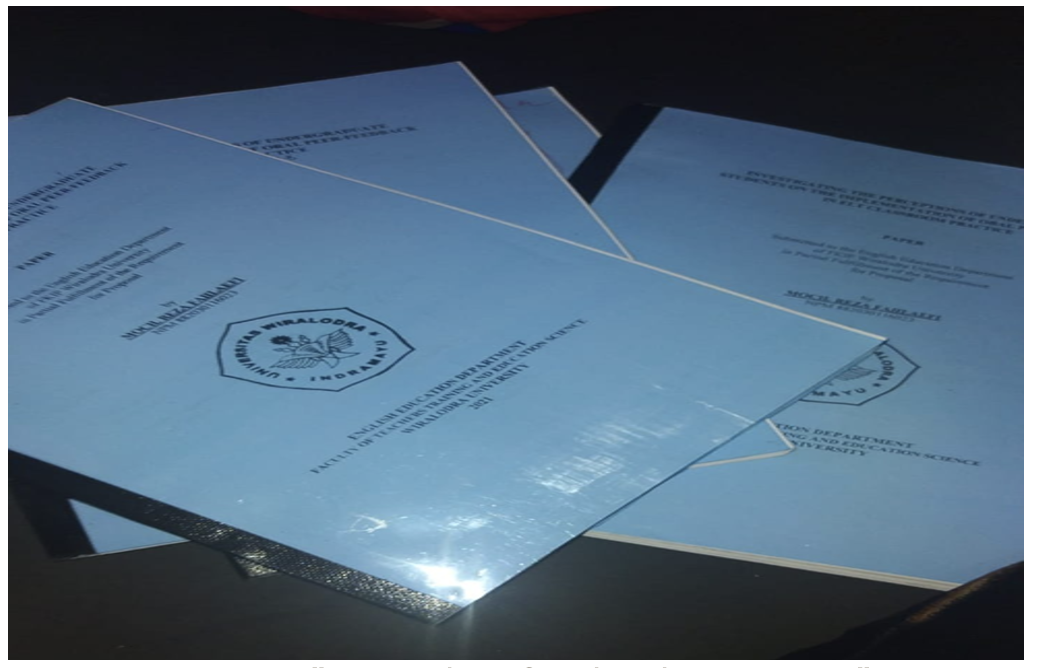
Figure 2: “Struggling for the thesis exam”
This photo captured Rizal’s effort to prepare the thesis examination which required a lot of time and energy.. Reading the report, revising the feedback from the supervisor, and discussing it with his partners were part of his daily activities in order to perform well on the day thesis exam. Feeling tired and exhausted were parts of struggling with the process of thesis examination.
During the data analysis, we extensively discussed with the participants about struggling as a theme that addressed from the analysis of participants online thesis examination experience. Struggling was a crucial effort depicted in a range of participants' emotional experiences. This finding corresponded to the previous research on capturing emotional experiences of doctoral students during the comprehensive exam (Koltz et al., 2010).
Anisa took this picture to express her feeling about the formalization of her thesis title.
This photo was taken in my grandparents’ front yard when I visited their house. When I was in the front yard, I saw this mango’s flower which seemed to be growth into fruit [sic]. The photo reflected my mood and my mind when my research’s title was approved by the Head of English Education Department. That mango’s flower was the beginning step of mango before finally it can be bear fruit. It described my feeling at that time, since it was the first step before finally I can do my research and graduate from universities [sic], I was so happy that time, but I could not be fully happy since there was still a long road ahead of me. I was also feeling nervous as well, since I had to confront my biggest fear as college student, but I need to go ahead and overcoming my fear to make my parent proud of me.
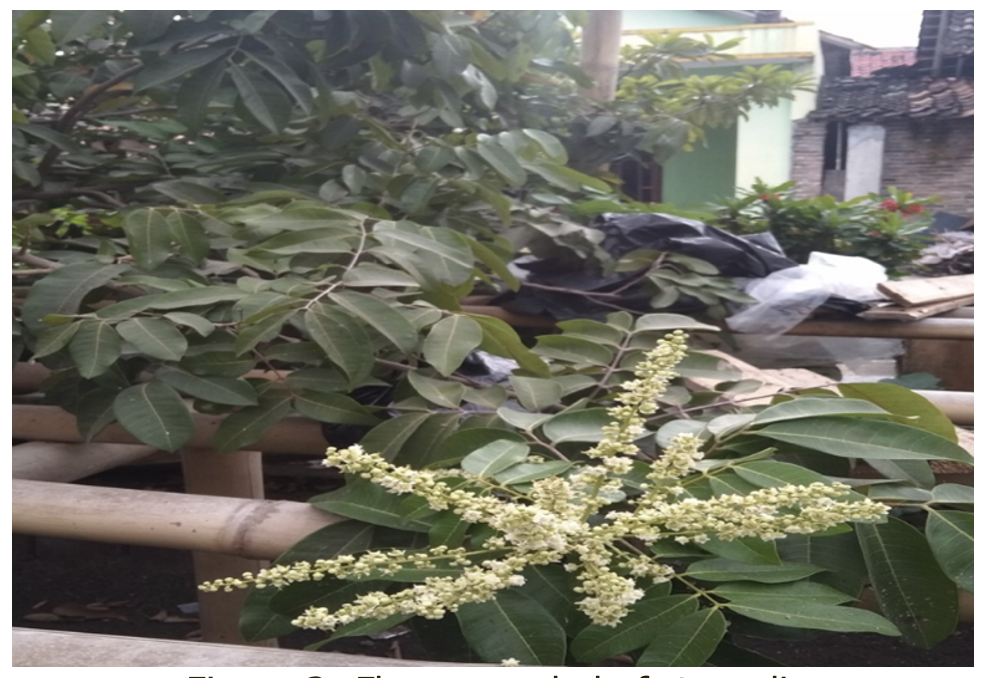
Figure 3: Flower symbol of struggling
At the beginning of her thesis writing, Anisa felt very happy for her thesis title was approved by the Head of the English Education Department. She felt confident because the first step in writing her thesis has been exceeded. The mango flower represented her feeling of joy and happiness as well. Besides her happy feeling, she was also feeling nervous and anxious facing her next step in writing her thesis. She did realize that she should struggle to finish her research, and there was still a long road ahead of her. She had to go ahead and cope with her fear of finishing her bachelor to make her family proud of her.
Self-doubt
Fatma describes her experience before online thesis examination. This was the photovoice of the picture she selected:
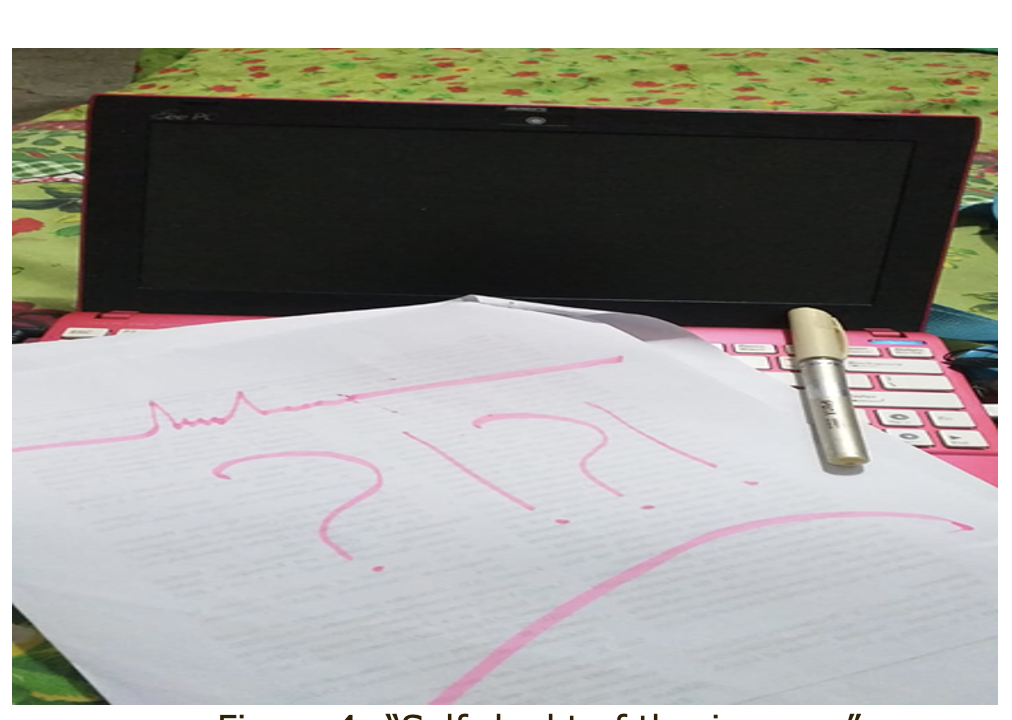
Figure 4: "Self-doubt of thesis exam"
I took a photo of my sketch and notebook. This notebook has been faithfully accompanied me in working my thesis. While, [sic] this sketch represents my conditions during online thesis examination; I felt self-doubt though I have studied hard, my heartbeat was really nervous [sic]because this presentation will [sic] determine my graduation while studying Wiralodra University. Even though it was stressful experience, I tried to perform best [sic] for my presentation and answer all the examiners questions. This exam taught me that being [sic] a bachelor degree was not easy; it was need a struggle and sacrifice. I have done my best that I think and other people think that the thesis exam is the most difficult thing. I am grateful to be able to pass this step. We should note that as long as we are willing to try, Allah will make it easier and show us the way to achieve it.
From the perspective of emotionality in assessment, this feeling portrayed the students’ experience when they faced the real situation in thesis examination. For example, the sentence “my heartbeat was really nervous because this presentation will determine my graduation” is the main concern where the student had to take part in a final project during their learning process in university. Thus, the emotionality of the students’ experience attempts to recover the crucial problem of how to handle it. These findings confirm what Bjerså et al. (2019) found: “Experiences of being a respondent on such occasions included feelings of sadness and disappointment, and even physical symptoms such as headaches” (p.5).
Another of the participants, Rijal, describes his experience during the online thesis examination. This was the photovoice of the picture he selected:
I chose this picture because this picture represented my feeling during the paper examination back then. To see myself in this picture was hard to believe that I actually had reached this step 2/3 [sic]. It means there still one-step closer [sic] to finish my education as a university student of Wiralodra University. Remembering the moment during the paper examination, that was indeed a challenging moment where I was required to present my presentation related to my research. My heart was beating twice faster[sic] than usual when presenting my presentation; I felt self-doubt though I have well prepared for the thesis exam. But I had set my mind to believe in myself that I would be able to pass this exam no matter the result was. Thanks for [sic] that, I could perform better than I thought.
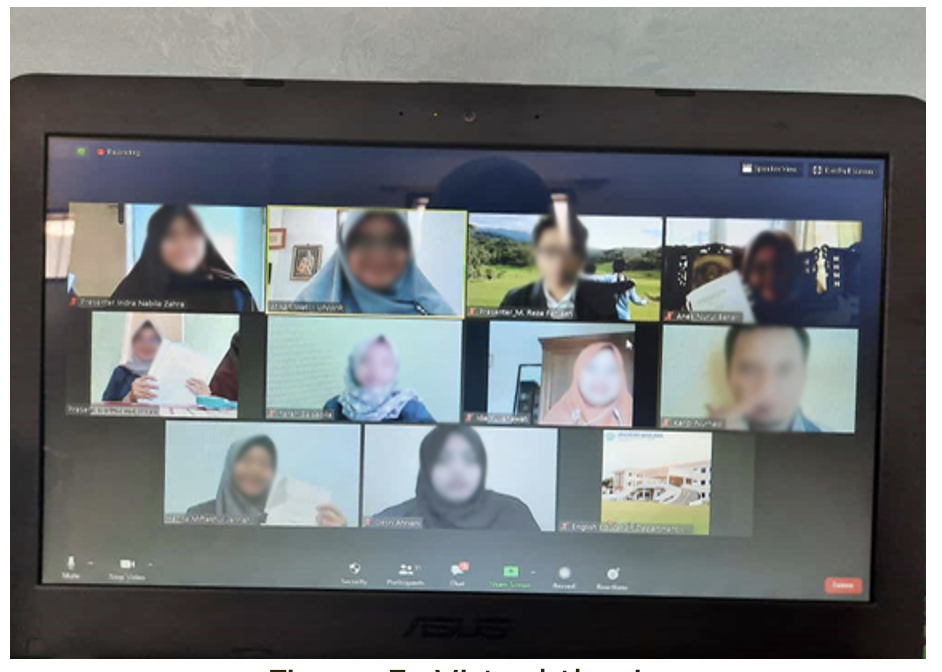
Figure 5: Virtual thesis exam
This student experienced different emotional conditions from the self-doubt dimension, such as being a decision maker or a follower. Additionally, preparation is a crucial stage because it determines the success of the thesis examination where the examinees must balance the psychological and emotional aspects. Thus, the change of the students’ emotion from uncertainty to the clear achievement helped them to discover their weaknesses during the thesis examination. This suggests that students’ emotions are dimensions that need to be considered by supervisors and examiners. This concurs with the findings reported by Bjerså et al (2019) that the examination has a vital role in building students’ knowledge construction.
Anisa showed her feelings with this photo.
This photo was taken at my house’s terrace when I sat in the terrace. When I sat in the terrace, I saw this birds which locked up in the cage [sic]. The photo reflected my mood and my mind when I was struggling in finishing my thesis. That bird was locked up in the cage and could not fly freely in the sky. That bird might face many fear and anxiety while it was in the cage, and that bird might have the desire to fly freely in the sky like other birds. It described my feeling in the process for finishing my thesis. I have to deal with my fear and anxiety, I felt like I lost my motivation and afraid to continue what I have done. I also want [sic] to graduate like other students but I was too afraid to finishing [sic] what I have started, but then I thought that I should be responsible for finishing what I have started, and finally I got my motivation back and could finishing my thesis.

Figure 6: Against the fear and self-doubt
From appraisal perspective (Martin & White, 2005), the data showed the student’s reflection on the examination had a myriad of emotional dimensions. For example, the clause “I was too afraid to finishing [sic]” showed the student’s difficult situation to handle the condition in the process of thesis examination” showed the student’s difficult situation to handle the condition in the thesis examination process. The participant compared her emotion to that of a bird without freedom. This metaphor depicted that the students’ emotion revealed the change of feeling when they prepare thesis examination from fear to motivation. Thus, it indicates that emotional engagement can lead to not only gaining motivation, but also in the feeling of responsibility and self-doubt condition.
Happiness
Fatma describes her experience after she had finished online thesis examination. This was the photovoice of the picture she selected.
My friend took this photo of me in my house when I was finished [sic] online thesis examination. Smile, degree and gifts was represented my happiness at that time. I can’t believe that I can do this; I can’t believe that I can through this and struggling from the laziness [sic]. I can through the feeling of anxious and unconfident [sic]. I was release the pressure [sic] for a moment before returning to the next stage of struggle. I’m really happy and relieved at that time because I felt that my effort is not in vain. I was proud of myself for this achievement. Then, the congratulations and the gifts from my friends was made me [sic] motivated, it was encourage me to be more spirit [sic] to correct the revisions of my thesis. I am very grateful to reach the goals in my study, this achievement made my parents felt [sic] happy and proud of me. Finally, even though after the thesis examination there was had homework for revisions, but I was still happy on that day.
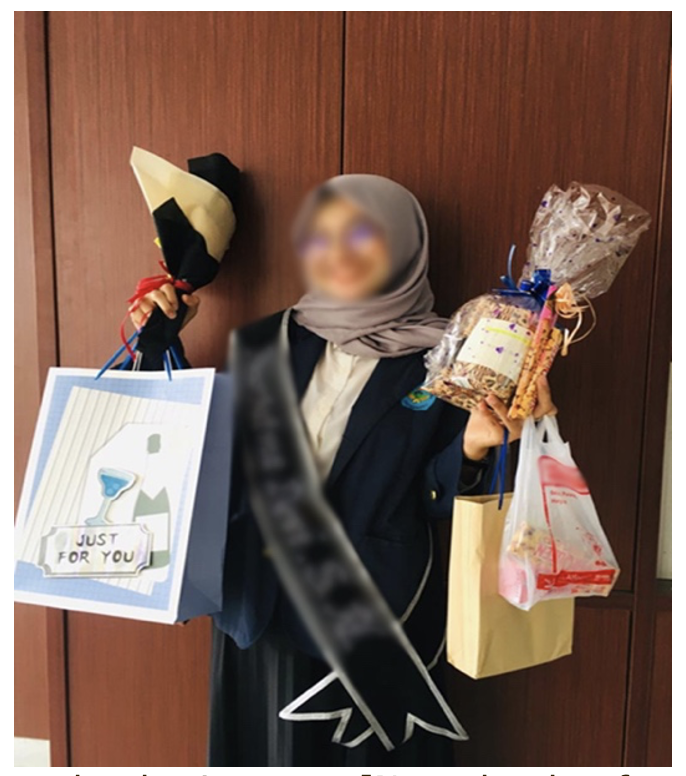
Figure 7: Happiness after the thesis exam.
[Note that her face is obscured for publication].
The data showed that the participant felt her positive emotions only after she finished her online thesis examination. She tried to capture her final emotion after everything was done perfectly. An example of this can be seen in the clause of “to be more spirit…” as a graduation from what emotion she felt before and after the thesis examination. This indicates that the student of thesis examination gradually experienced a change of emotionality in terms of happiness.
Participant Anisa showed her feelings with this photo.
This photo was taken in my grandparents’ front yard when I visited their house. When I was in the front yard, I saw this flower that has been blooming [sic] into beautiful flower. The photo reflected my mood and my mind when the revision of my thesis was approved by all the examiners. That flower could bloom into such a beautiful flower after passing many phases in its growth. It described my feeling at that time, since finally I could get to the last stage of my college’s life [sic] and I could graduate from university, like what I have been dreaming of since I was freshman. I felt like all of my sadness and anxiety has gone away and I felt so happy that finally I would graduate from university. My feeling was like that blooming flower, and I was so happy at that time.
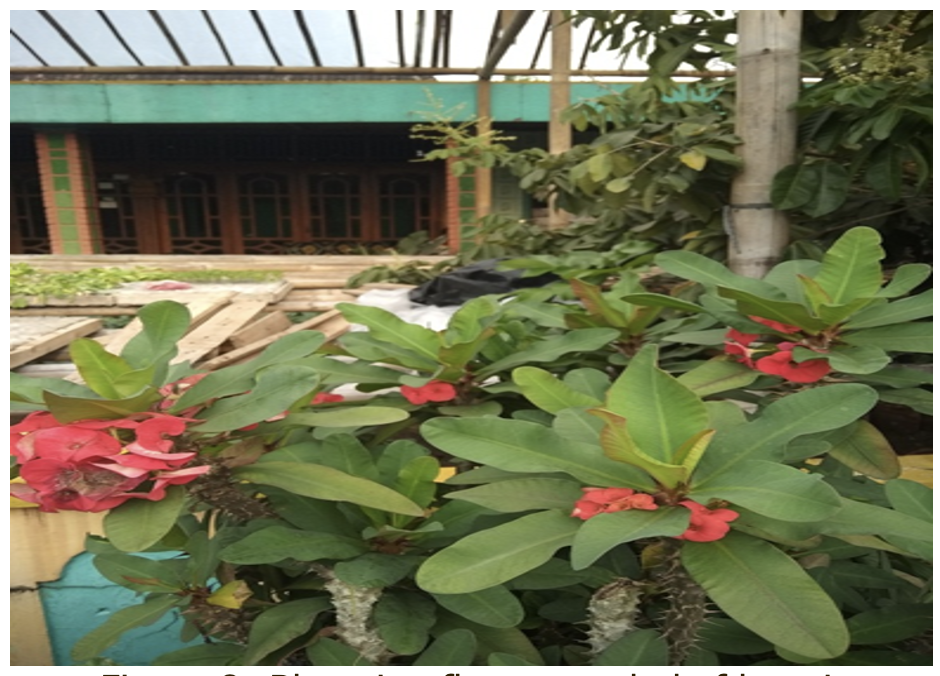
Figure 8: Blooming flower symbol of happiness
Looking at the flowers taken by Anisa, it can be concluded that happiness comes when the process had finished. The process of writing, consultation, proposal seminar, revision, thesis defence and final revision was quite draining on Anisa’s emotions. Yet, she depicted her emotions and feelings by taking some blooming flowers showing her entirely happiness. Red is a symbol of courage and love as well. It is a symbol of her last stage in her bachelor’s degree, as well as her first step of to be a real scholar in society. It was her dream to become a scholar and finally she could prove to the world that she could conquer her nervousness and anxiety related to her thesis.
Implications
Prior research in initial teacher education related to students’ online thesis experiences was relatively limited, and in particular, there has been little adoption of photovoice to capture student-teachers’ emotional experiences thesis defense. Our findings reveal that emotions accompany the experience of student-teachers’ thesis examination. That finding can provide benefit to initial teacher education and supervising programs.
Teacher Educators
Driven by participants’ experiences pursuing a bachelor’s degree for student-teachers in teacher education program can be a challenging process. Drawing on the range of emotional experiences including struggling, self-doubt, and happiness captured in this research, it seems crucial to help student-teachers prepare a strategic plan to pass the thesis exam successfully. For instance, teacher educators might provide a mentoring discussion with supervisors.
The mentoring discussion could provide: 1) sharing and discussing the supervisor's experiences with thesis examination to motivate student-teachers 2) planning of mentoring program to be successful, and 3) evaluating the whole process of mentoring to ensure that student-teachers felt satisfied.
Drawing on the theme of struggling, data showed that Fatma expressed a wide range of emotions during online thesis examination between ‘giving up' and ‘keeping doing’. Participants experienced a critical incident when making this choice. Finally, she chose 'keep doing' to acquire her main goal as bachelor’s degree. Thus, it is crucial for teacher educators to support student-teachers on their effort in thesis examination by providing intensive mentoring before the exam.
The theme of self-doubt was expressed throughout the whole process of thesis examination. It is imperative that supervisors encourage students in expressing their emotions. Supervisors can share their own experience of the thesis examination to maintain their spirit and motivation.
The theme of happiness was the peak of student-teachers expression after passing through a range of emotional experiences where they could make them and their parents feel proud.
Conclusion
Guided by Wang and Burries photovoice (1997) and the phenomenological method, we captured student-teachers experiences while participating in an online thesis examination. The adoption of photovoice in this study was due to the relatively sparse research on student-teachers’ voicing of emotion, in particular during their critical moments of thesis examination. The photos encouraged student-teachers to share their emotions, feelings, and experience at different times. Although the findings of study gives an insight into the use of photovoice to explore the participants’ experiences during thesis examination, it has its limitations in terms of duration and data collection. Therefore, future longitudinal studies may be needed to explore students' experiences both during the examination period and after it.
References
Bjerså, K., Shams, K., & Fagevik Olsén, M. (2019). Physiotherapy undergraduate students’ experiences of bachelor’s thesis examination. European Journal of Physiotherapy, 21(1), 56-63. http://doi.org/10.1080/21679169.2018.1472636
Bourke, S., & Holbrook, A. P. (2013). Examining PhD and research masters theses. Assessment & Evaluation in Higher Education, 38(4), 407-416. https://doi.org/10.1080/02602938.2011.638738
Creswell, J. W., & Poth, C. N. (2016). Qualitative inquiry and research design: Choosing among five approaches (4th ed.). Sage.
Dally, K., Holbrook, A., Lovat, T., & Fairbairn, H. (2020). Supervisor perspectives on the ‘end-stage’ of the doctoral examination process. Higher Education Research & Development, 41(2). 1-15. http://doi.org/10.1080/07294360.2020.1847049
Demir, K & Qureshi, A.M (2019) Pakistani science teachers’ experiences of professional development: A phenomenological case study.Journal of Science Teacher Education, 3(8), 838-855. https://doi.org/10.1080/1046560X.2019.1607707
Esterberg, K. G. (2002). Qualitative methods in social research. McGraw-Hill.
Foster-Fishman, P., Nowell, B., Decond, Z., Nievar, M. A., & McCann, P. (2005). Using methods that matter: The impact of reflection, dialogue, and voice. American Journal of Community Psychology, 36(3/4), 275–291. https://doi.org/10.1007/s10464-005-8626-y
Guloy, S., Hum, G., & O’Neill, D. K. (2020). Voices at the gate: Faculty members’ and students’ differing perspectives on the purposes of the PhD comprehensive examination. Assessment & Evaluation in Higher Education, 45(2), 279-291.https://doi.org/10.1080/02602938.2019.1637819
Harley, J. M., Lou, N. M., Liu, Y., Cutumisu, M., Daniels, L. M., Leighton, J. P., & Nadon, L. (2020). University students’ negative emotions in a computer-based examination: The roles of trait test-emotion, prior test-taking methods and gender. Assessment & Evaluation in Higher Education. http://doi.org/10.1080/02602938.2020.1836123
Hickman, R., & Kiss, L. (2010). Cross‐curricular gallery learning: A phenomenological case study. International Journal of Art & Design Education, 29(1), 27-36. http://doi.org/10.1111/j.1476-8070.2010.01635.x
Holbrook, A., Burke, R., & Fairbairn, H. (2020). Linguistic diversity and doctoral assessment: Exploring examiner treatment of candidate language. Higher Education Research & Development, 41(2). http://doi.org/10.1080/07294360.2020.1842336
Kingery, F. P., Naanyu, V., Allen, W., & Patel, P. (2016). Photovoice in Kenya: Using a community-based participatory research method to identify health needs. Qualitative Health Research, 26(1), 92-104. https://doi.org/10.1177%2F1049732315617738
Koltz, R. L., Odegard, M. A., Provost, K. B., Smith, T., & Kleist, D. (2010). Picture perfect: Using Photo-Voice to explore four doctoral students' comprehensive examination experiences. Journal of Creativity in Mental Health, 5(4), 389-411.http://doi.org/10.1080/15401383.2010.527797
Lim, L.-A., Dawson, S., Gašević, D., Joksimović, S., Pardo, A., Fudge, A., & Gentili, S. (2021). Students’ perceptions of, and emotional responses to, personalised learning analytics-based feedback: an exploratory study of four courses. Assessment & Evaluation in Higher Education, 46(3).
Lynch, M. W., & Bengtsson, A. R. (2018). Photovoice: A pedagogical tool to promote student engagement with social justice issues. Social Dialogue Magazine, 19, 17-19. https://socialdialogue.online/sd19/08_article.html
Martin, J. R., & White, P. R .R. (2005). The language of evaluation. Appraisal in English. Palgrave Macmillan.
Maxwell, J. A. (2012). Qualitative research design: An interactive approach. Sage.
Malka, M. (2020). Photo-voices from the classroom: Photovoice as a creative learning methodology in social work education. Journal of Social Work Education, 41(1), 4-20. https://doi.org/10.1080/02615479.2020.1789091
Meinhardt, J., & Pekrun, R. (2003). Attentional resource allocation to emotional events: An ERP study. Cognition and Emotion, 17(3), 477-500. https://doi.org/10.1080/02699930244000039
Moustakas, C. (1994). Phenomenological research methods. Sage.
Myyry, L., Karaharju-Suvanto, T., Vesalainen, M., Virtala, A.-M., Raekallio, M., Salminen, O., Vuorensola, K., & Nevgi, A. (2019). Experienced academics' emotions related to assessment. Assessment & Evaluation in Higher Education. 45(1), 1-13. https://doi.org/10.1080/02602938.2019.1601158
Pekrun, R., Goetz, T., Perry, R. P., Kramer, K., Hochstadt, M., & Molfenter, S. (2004). Beyond test anxiety: Development and validation of the test emotions questionnaire (TEQ). Anxiety, Stress & Coping, 17(3), 287-316. https://doi.org/10.1080/10615800412331303847
Pekrun, R., & Perry, R. P. (2014). Control-value theory of achievement emotions. In R. Pekrun & L. Linnenbrink-Garcia (Eds.), International handbook of emotions in education (pp. 130-151). Routledge.
Peterson, E. R., Brown, G. T. L., & Jun, M. C. (2015). Achievement emotions in higher education: A diary study exploring emotions across an assessment event. Contemporary Educational Psychology, 42, 82-96. https://doi.org/10.1016/j.cedpsych.2015.05.002
Safodien, M. (2018). Using photovoice as a reflective tool with first year social work students. Social Dialogue Magazine, 19.https://socialdialogue.online/sd19/09_article.html
Schutz, P. A., Benson, J., & Decuir-Gunby, J. T. (2008). Approach/avoidance motives, test emotions, and emotional regulation relate to testing. Anxiety, Stress and Coping, 21(3), 263-281. https://doi.org/10.1080/10615800701787672
Vehviläinen, S., Löfström, E., & Nevgi, A. (2018). Dealing with plagiarism in the academic community: Emotional engagement and moral distress. Higher Education, 75(1), 1-18. https://doi.org/10.1007/s10734-017-0112-6
Villacañas de Castro, L. S. (2017). We are more than EFL teachers–we are educators’: Emancipating EFL student-teachers through photovoice. Educational Action Research, 25(4), 610-629. http://doi.org/10.1080/09650792.2016.1215930
Wang, C. C. (2006). Youth participation in photovoice as a strategy for community change. Journal of Community Practice, 14(1-2), 147–161. https://doi.org/10.1300/J125v14n01_09
Wang, C., & Burris, M. A. (1994). Empowerment through photo novella: Portraits of participation. Health Education Quarterly, 21(2), 171-186. https://doi.org/10.1177/109019819402100204
Wang, C., & Burris, M. A. (1997). Photovoice: Concept, methodology, and use for participatory needs assessment. Health Education & Behavior, 24(3), 369-387. https://doi.org/10.1177%2F109019819702400309
Wang, C., & Pies, C. (2004). Family, maternal, and child health through photovoice. Maternal and Child Health Journal, 8(2), 95–102.https://doi.org/10.1023/B:MACI.0000025732.32293.4f

